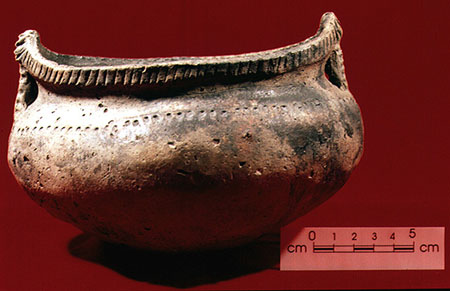
Exhibit Specimen 16
(CMCC VIII-F:15577)
 In 1884, Mr. C.A. Hirschfelder sold a major collection of pre-contact Native objects to the Geological Survey of Canada. At that time there was no Museum of Civilization or anything remotely resembling that in Ottawa. Nonetheless, the GSC was quite involved in documenting both past and then present Native life. Those collections formed the nucleus around which the Anthropology Division was created, which eventually, through many different stages, resulted in the Canadian Museum of Civilization.
In 1884, Mr. C.A. Hirschfelder sold a major collection of pre-contact Native objects to the Geological Survey of Canada. At that time there was no Museum of Civilization or anything remotely resembling that in Ottawa. Nonetheless, the GSC was quite involved in documenting both past and then present Native life. Those collections formed the nucleus around which the Anthropology Division was created, which eventually, through many different stages, resulted in the Canadian Museum of Civilization.
This particular specimen was found somewhere near Burlington Bay, in Barton Township, Wentworth County. The site was likely located in what is now the southern part of the present limits of the city of Hamilton, Ontario.
It has two distinguishing features. The first is its oblong or oval shape. The second is the use appliqués below castellations to form strap handles. The decoration on the pot is relatively simple with oblique lines incised along the collar and a simple line of indentations marking the shoulder of the otherwise smooth-surfaced body.
The reported location of the original find as well as the decorative elements described above, suggest that this vessel was manufactured by ancestors of the Neutral Iroquoian peoples who were situated around the west end of Lake Ontario at contact times.
Further Reading
Lennox, P.A. and W.R. Fitzgerald
1990 The Culture History and Archaeology of the Neutral Iroquoians. In The Archaeology of Southern Ontario to A.D. 1650. Occasional Publication of the London Chapter, OAS, No.5:405-456.
Smith, P.J. and D. Mitchell
1998 Bringing Back the Past. Historical Perspectives on Canadian Archaeology. Archaeological Survey of Canada Mercury Series Paper No.158. Canadian Museum of Civilization, Hull.
Next
Previous
Back to the beginning